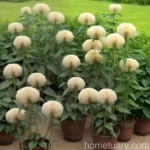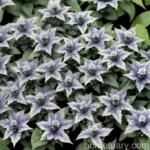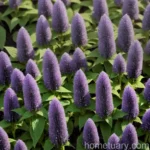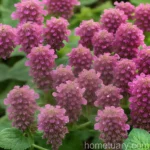The Fascinating Plant: Jerusalem Sage (Phlomis fruticosa)
Plants have always been an integral part of human civilization, providing us not only with aesthetic beauty but also with numerous uses ranging from medicinal to ornamental. One such plant that has been gaining popularity in the gardening and herbal medicine communities is the Jerusalem Sage, scientifically known as Phlomis fruticosa. This evergreen perennial herbaceous plant is not only visually appealing with its vibrant flowers and fuzzy leaves, but it also holds a myriad of cultural, culinary, and medicinal significance that makes it a valuable addition to any garden.
In this comprehensive guide, we will explore the captivating world of Jerusalem Sage, from its cultivation and uses to its folklore and ecological value. Join me on this journey as we unravel the secrets and wonders of this remarkable plant that has intrigued botanists, herbalists, and garden enthusiasts alike.
What is the Jerusalem Sage (Phlomis fruticosa)?
Jerusalem Sage, also commonly referred to as Phlomis fruticosa, is a species of flowering plant in the mint family, Lamiaceae. It is native to regions around the Mediterranean, where it can be found adorning hillsides, rocky terrains, and scrublands with its stunning presence. The plant is characterized by its dense clusters of bright yellow flowers and velvety, heart-shaped leaves, which emit a subtle yet pleasant fragrance. It is a relatively low-maintenance plant, making it an ideal choice for gardeners looking to add a touch of allure to their landscapes without requiring excessive care.
Key Takeaways – Jerusalem Sage (Phlomis fruticosa)
Before delving further into the intricacies of cultivating and caring for Jerusalem Sage, let’s take a glimpse at some key takeaways about this enchanting plant:
- Botanical Name: Phlomis fruticosa
- Common Name: Jerusalem Sage
- Family: Lamiaceae (Mint family)
- Native Range: Mediterranean region
- Characteristics: Evergreen perennial with velvety leaves and yellow flowers
- Cultural Significance: Utilized in herbal remedies, folklore, and traditional medicine
- Gardening Uses: Ornamental landscaping, drought-tolerant gardens, and pollinator habitat
- Growing Conditions: Thrives in sunny, dry climates and well-drained soil
- Popularity: Gaining recognition for its aesthetic appeal and ecological benefits
Now that we have an overview of Jerusalem Sage, let’s embark on a comprehensive exploration of its various aspects, ranging from its cultural uses to its growth requirements and ecological significance.
Cultivation of Jerusalem Sage
Cultivating Jerusalem Sage can be an immensely rewarding experience, as it not only adds natural beauty to the surroundings but also offers a range of practical applications and benefits. Whether you are a seasoned gardener or a novice enthusiast, understanding the key elements of growing and nurturing this plant is essential for ensuring its thriving presence in your garden or landscape.
The Basics: What Does Jerusalem Sage Need to Thrive?
Water
One of the most striking features of Jerusalem Sage is its remarkable ability to withstand drought and thrive in dry conditions. This makes it an excellent choice for gardens and landscapes with minimal water availability. However, especially during its initial establishment phase, adequate watering is crucial to promote healthy root development. Once established, the plant is remarkably resilient and can endure prolonged periods of drought without significant impact on its overall health.
Sunlight
Jerusalem Sage is a sun-loving plant that flourishes in full sunlight. It is best suited for locations with ample direct sunlight, where it can bask in the warmth and absorb the energy it needs for robust growth and blooming. When selecting a spot for planting Jerusalem Sage, ensure that it receives at least 6-8 hours of direct sunlight per day to support its optimal development.
Fertilizer
As a relatively low-maintenance plant, Jerusalem Sage does not demand frequent fertilization. In fact, excessive fertilization can lead to lush foliage at the expense of flowering. If the soil quality is poor, a balanced, slow-release fertilizer can be applied in spring to support healthy growth. Otherwise, minimal fertilizer requirements make Jerusalem Sage an eco-friendly addition to sustainable gardens.
Soil
The success of cultivating Jerusalem Sage heavily relies on well-draining soil. It detests waterlogged conditions and is susceptible to root rot if planted in heavy, compacted soils. Therefore, it is paramount to ensure that the soil is loose, airy, and facilitates efficient drainage to prevent water stagnation. Sandy or loamy soils with good permeability are highly suitable for the optimal growth of Jerusalem Sage.
Pruning
Pruning is an essential aspect of maintaining the health and aesthetic appeal of Jerusalem Sage. While the plant exhibits a naturally bushy and well-structured form, occasional pruning helps to remove dead or diseased foliage, promote air circulation, and shape the plant to suit specific landscaping preferences. Pruning is typically performed in late winter or early spring before the onset of new growth to rejuvenate the plant and encourage prolific flowering during the growing season.
Propagation
There are several methods for propagating Jerusalem Sage, including division, cuttings, and seed propagation. Each method has its distinct advantages and challenges, and the choice of propagation technique largely depends on the specific preferences and requirements of the gardener. Division is a common method for propagating mature Jerusalem Sage plants, while cuttings and seed propagation are ideal for expanding the plant population or cultivating new individuals from selected parent plants.
Container Popularity
The versatile nature of Jerusalem Sage makes it well-suited for container cultivation, particularly in regions with limited outdoor space or constraints on soil quality. This flexibility allows gardeners to adorn their patios, balconies, or indoor spaces with the captivating presence of Jerusalem Sage, adding a touch of natural elegance and fragrance to confined urban environments. Container-grown Jerusalem Sage requires well-draining potting soil and regular monitoring of watering needs to ensure optimal growth and vitality.
Common Uses of Jerusalem Sage
The captivating appeal and multifaceted nature of Jerusalem Sage lend themselves to an array of uses, ranging from cultural and historical significance to practical applications in culinary and medicinal domains. Let’s delve into the diverse uses of Jerusalem Sage that have intrigued and inspired plant enthusiasts and herbalists for generations.
Cultural Significance and Folklore
Throughout history, Jerusalem Sage has been steeped in folklore and traditional beliefs, often associated with themes of protection, purification, and wellbeing. Its aromatic leaves were believed to ward off evil spirits and offer blessings of health and prosperity, leading to its inclusion in various rituals, ceremonies, and spiritual traditions. The plant’s cultural significance has transcended generations, with its use in traditional festivities, symbolic decorations, and ceremonial offerings in diverse cultural contexts.
Medicinal Properties and Herbal Remedies
Jerusalem Sage is valued for its medicinal properties and has been utilized in herbal remedies for addressing various ailments. The plant’s leaves and flowers contain compounds that exhibit anti-inflammatory, antimicrobial, and antioxidant properties, making it a valuable resource in natural medicine. Infusions and decoctions prepared from Jerusalem Sage have been used to alleviate respiratory discomfort, soothe digestive issues, and promote overall wellness. Its inclusion in traditional medicine and herbal concoctions underscores its importance as a natural remedy for promoting health and vitality.
Culinary Uses and Fragrance
While Jerusalem Sage is primarily acclaimed for its visual allure and medicinal attributes, it also offers delightful culinary potential. The aromatic leaves of the plant emit a subtle yet distinct fragrance, which imparts a unique flavor when used as a seasoning or herbal infusion. Jerusalem Sage leaves can be utilized to add a mild, earthy essence to culinary creations, enriching dishes with a touch of Mediterranean charm.
Landscape Design and Ornamental Uses
The ornamental value of Jerusalem Sage cannot be overstated, as it boasts a striking visual appeal that enhances the aesthetics of any garden or landscape. Its vibrant yellow flowers and velvety foliage complement a range of design styles, from naturalistic, wildflower gardens to formal, structured landscapes. Jerusalem Sage is frequently employed in landscape design to create visual focal points, accentuate rock gardens, and populate drought-tolerant landscapes with vibrant splashes of color and texture.
Ethnobotanical Uses and Wildlife Habitat
The ecological significance of Jerusalem Sage extends beyond its ornamental and medicinal uses, as it plays a pivotal role in fostering biodiversity and ecological balance. The plant serves as a valuable habitat and food source for pollinators, including bees, butterflies, and other beneficial insects, contributing to the preservation of wildlife and the promotion of sustainable ecosystems. Its significance in ethnobotanical practices further underscores its value as a cultural and ecological asset that enriches the natural environment.
Common Diseases and Pests Affecting Jerusalem Sage
While Jerusalem Sage is generally resilient and resistant to most pests and diseases, certain environmental conditions and stressors can render it susceptible to specific issues. Understanding the common diseases and pests that may affect Jerusalem Sage is crucial for implementing proactive measures to safeguard the plant’s health and vigor.
Disease Diagnosis
Phytophthora Root Rot
Phytophthora root rot, caused by soil-borne pathogens of the Phytophthora genus, poses a significant threat to Jerusalem Sage, particularly in excessively moist or poorly-drained soil. The disease manifests as yellowing, wilting, and eventual death of the plant due to root damage and compromised nutrient uptake. To mitigate the impact of phytophthora root rot, it is essential to ensure proper soil drainage and avoid overwatering, as well as the incorporation of disease-resistant cultivars where applicable.
Powdery Mildew
Powdery mildew is a fungal disease that can affect Jerusalem Sage, leading to the development of a powdery, white fungal growth on the plant’s leaves and stems. This unsightly manifestation not only diminishes the plant’s aesthetic appeal but also interferes with its photosynthetic capacity and overall vitality. To combat powdery mildew, maintaining good air circulation, avoiding overhead watering, and employing organic fungicidal sprays can help prevent and manage the spread of the disease.
Common Pests
Aphids
Aphids are notorious pests that can afflict Jerusalem Sage, sucking sap from the plant’s tender shoots and causing leaf distortion, wilting, and the secretion of sticky honeydew. These tiny, pear-shaped insects can multiply rapidly and colonize the plant, posing a threat to its overall health. Implementing natural predators, such as ladybugs or lacewings, and using insecticidal soaps can help control aphid infestations and maintain the vigor of Jerusalem Sage.
Whiteflies
Whiteflies, characterized by their small size and powdery white wings, are another common pest that can impact Jerusalem Sage. These sap-feeding insects weaken the plant by draining its resources, leading to stunted growth, yellowing of leaves, and increased susceptibility to secondary infections. Biological control methods and the application of horticultural oils can aid in managing whitefly populations and preserving the health of Jerusalem Sage.
Botanist’s Tips for Growing Jerusalem Sage
As a plant enthusiast, it is essential to be equipped with valuable insights and tips for successfully growing and caring for Jerusalem Sage. Here are some expert recommendations and best practices to guide your journey in cultivating and nurturing this captivating plant:
- Siting Considerations: Select a well-draining, sunny location for planting Jerusalem Sage, ensuring ample sunlight and good soil permeability.
- Watering Practices: During the establishment phase, provide regular watering to facilitate robust root development, but refrain from overwatering once the plant is established.
- Soil Requirements: Prioritize loose, airy soils with good drainage, and consider incorporating organic matter to enhance soil structure and nutrition.
- Pruning Techniques: Engage in annual pruning to remove dead or overgrown foliage, shaping the plant to maintain its vigor and aesthetic appeal.
- Propagation Methods: Explore division, cuttings, or seed propagation to propagate Jerusalem Sage, understanding the advantages and complexities of each technique.
- Pest and Disease Management: Monitor for common pests and diseases, implementing preventive measures and natural controls to mitigate potential threats to the plant’s health.
- Container Cultivation: If space is limited, consider cultivating Jerusalem Sage in containers, providing appropriate soil and watering to sustain optimal growth.
Fun Facts about Jerusalem Sage
While basking in the allure of Jerusalem Sage and its multidimensional attributes, let’s uncover some intriguing fun facts that illuminate the unique qualities and cultural significance of this exceptional plant:
- The aromatic foliage of Jerusalem Sage has been historically used in incense blends and aromatic rituals, adding a touch of enchantment to ceremonial practices.
- The vibrant yellow flowers of Jerusalem Sage attract a multitude of pollinators, contributing to the vibrancy and ecological balance of natural habitats.
- In traditional medicine, Jerusalem Sage has been revered for its ability to promote respiratory wellness and soothe digestive discomfort, embodying the rich tradition of herbal healing.
- Jerusalem Sage features prominently in folklore and cultural traditions around the Mediterranean, symbolizing virtues of vitality, protection, and spiritual wellbeing.
Links to External Resources
To further enrich your understanding of Jerusalem Sage and explore diverse perspectives on its cultivation, uses, and ecological significance, here are some valuable external resources that offer comprehensive insights and guidance:
- University of California Agriculture & Natural Resources – Growing Jerusalem Sage
- Royal Horticultural Society – Phlomis fruticosa Plant Profile
- The Herb Society of America – Jerusalem Sage Culture & Uses
These resources offer a wealth of information, scientific data, and practical recommendations for enthusiasts, gardeners, and researchers keen on exploring the captivating realm of Jerusalem Sage and its diverse applications.
In conclusion, Jerusalem Sage (Phlomis fruticosa) stands as a testament to the natural beauty, cultural significance, and ecological value embodied by botanical treasures. From its resilient nature and ornamental allure to its multifaceted uses in herbal medicine and folklore, this exceptional plant continues to captivate and inspire individuals across diverse domains. Embracing the essence of Jerusalem Sage unveils a world of enchantment, wisdom, and vitality, inviting us to forge deeper connections with the natural wonders that adorn our lives.















